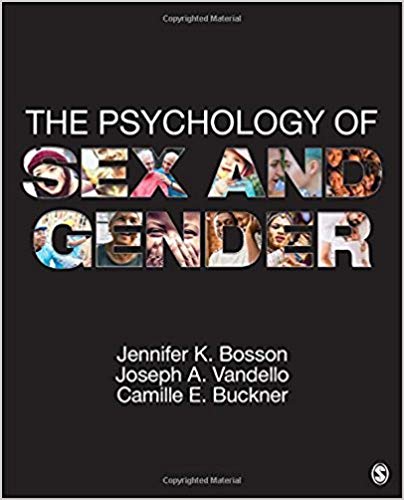In Stock
Test Bank For The Psychology Of Sex And Gender 1st Edition by Jennifer Katherine Bosson
Digital item No Waiting Time Instant DownloadISBN-13: 978-1506331324 ISBN-10: 1506331327
Original price was: $67.00.$19.00Current price is: $19.00.
Test Bank For The Psychology Of Sex And Gender 1st Edition by Jennifer Katherine Bosson
Instructor Resource Bosson, The Psychology of Sex and Gender 1e
SAGE Publishing, 2018
Chapter 2: Studying Sex and Gender
Test Bank
Multiple Choice
1. Which of the following is FALSE about sex and math ability?
A. Girls tend to have higher math anxiety than boys.
B. Girls would likely score higher than boys on math tests if not for math anxiety.
C. Math performance is predicted less by sex than by socioeconomic status.
D. Large-scale reviews show no overall sex differences in math performance.
Ans: B
Learning Objective: 2-1: Evaluate the meaning of sex differences.
Cognitive Domain: Knowledge
Answer Location: Studying Sex and Gender
Difficulty Level: Easy
2. Which of the following is FALSE regarding common beliefs about sex differences?
A. Young girls have been found to be slightly more talkative than young boys.
B. Part of the reason women are reluctant to engage in casual sex is because they do not expect it to be pleasurable.
C. Adult women tend to use more verbose language than adult men.
D. Women and men perform similarly on tests of math ability.
Ans: C
Learning Objective: 2-1: Evaluate the meaning of sex differences.
Cognitive Domain: Knowledge
Answer Location: Studying Sex and Gender
Difficulty Level: Easy
3. Imagine Mark is studying sex differences in emotional expression. His study contains measures for seven different types of emotional expression. He finds that women score higher on one of these and men score higher on another one. He interprets his findings as suggesting largely different styles of emotional expression across men and women. Mark’s interpretation indicates a ______ approach.
A. biological
B. cross-cultural
C. minimalist
D. maximalist
Ans: D
Learning Objective: 2-1: Evaluate the meaning of sex differences.
Cognitive Domain: Application
Answer Location: What Is the Meaning of Difference?
Difficulty Level: Hard
4. When psychologists report discovering sex differences on some variable (e.g., optimism) what do they typically mean by this?
A. that these differences emerge from distinct biological sex categories
B. that the difference between sexes has a large effect size
C. that the difference has a practical level of significance
D. that the observed difference is unlikely to have occurred due to chance
Ans: D
Learning Objective: 2-1: Evaluate the meaning of sex differences.
Cognitive Domain: Comprehension
Answer Location: What Is the Meaning of Difference?
Difficulty Level: Medium
5. Some gender researchers argue that a maximalist approach is problematic because ______.
A. it ignores important sex differences
B. it perpetuates overgeneralized beliefs about the sexes
C. it prioritizes the effects of culture too strongly over biology
D. research on sex differences cannot be objective
Ans: B
Learning Objective: 2-1: Evaluate the meaning of sex differences.
Cognitive Domain: Comprehension
Answer Location: What Is the Meaning of Difference?
Difficulty Level: Medium
6. Which of the following does NOT accurately describe science?
A. It most heavily emphasizes evidence that is consistent with theory.
B. It is defined more by its methods than by its contents.
C. Repeating experiments over again is a key step in conducting science.
D. Scientific research often relies on evidence that is probabilistic.
Ans: A
Learning Objective: 2-2: Explain the scientific method and specific quantitative and qualitative methods used in the study of sex and gender.
Cognitive Domain: Comprehension
Answer Location: What Is Science?
Difficulty Level: Medium
7. Which of the following is typically the first step in the scientific method?
A. study design
B. replication
C. hypothesis generation
D. data collection
Ans: C
Learning Objective: 2-2: Explain the scientific method and specific quantitative and qualitative methods used in the study of sex and gender.
Cognitive Domain: Knowledge
Answer Location: The Scientific Method
Difficulty Level: Easy
8. Which of the following is the best example of a hypothesis?
A. An observation that men tend to walk faster in pairs than when alone.
B. The idea that judgments are driven more by emotion than by conscious reasoning.
C. The belief that people rationalize unfairness in order to avoid cognitive dissonance.
D. A prediction that women will score higher on a test of verbal ability than men.
Ans: D
Learning Objective: 2-2: Explain the scientific method and specific quantitative and qualitative methods used in the study of sex and gender.
Cognitive Domain: Application
Answer Location: The Scientific Method
Difficulty Level: Hard
9. A testable prediction regarding the outcome of a study is called a(n) ______.
A. theory
B. hypothesis
C. replication
D. boundary condition
Ans: B
Learning Objective: 2-2: Explain the scientific method and specific quantitative and qualitative methods used in the study of sex and gender.
Cognitive Domain: Knowledge
Answer Location: The Scientific Method
Difficulty Level: Easy
10. Which of the following best represents the order of the scientific process?
A. generate hypothesis replicate collection and analysis study design
B. generate hypothesis study design collection and analysis disseminate results
C. study design generate hypothesis disseminate results collection and analysis
D. study design collection and analysis generate hypothesis disseminate results
Ans: B
Learning Objective: 2-2: Explain the scientific method and specific quantitative and qualitative methods used in the study of sex and gender.
Cognitive Domain: Comprehension
Answer Location: The Scientific Method
Difficulty Level: Medium

Reviews
There are no reviews yet.